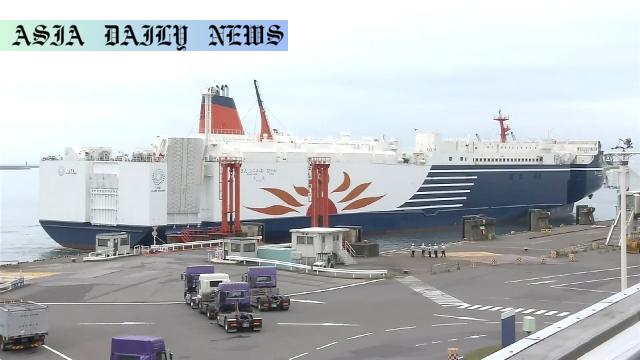Tsunami Warning: Passengers relieved to finally disembark in Hokkaido after ferries anchored overnight offshore.
- Ferries stayed offshore in Hokkaido due to tsunami warning.
- Passengers disembarked with special permission after 24 hours.
- No health issues reported; passengers expressed mixed feelings.

Tsunami Advisory: Ferries Cautiously Navigate Safety Measures
In a gripping sequence of events prompted by a tsunami warning, four ferries remained anchored offshore to ensure passenger and crew safety. This precautionary measure came under the advisement of the Japan Coast Guard, whose rapid response to potential threats showcased a focus on public protection. These ferries, en route from Oarai and Sendai ports, ultimately docked safely at Tomakomai port in Hokkaido after spending over 24 hours at sea. While the safety-focused approach was commendable, the psychological toll on passengers highlights the challenges that arise during natural disaster contingencies.
The ferries, carrying passengers of varying demographics, adhered to rigorous safety protocols while offshore. Amid uncertainty, passengers engaged in proactive measures such as conversing with fellow travelers and keeping updated through television broadcasts, showcasing resilience and adaptability during a natural crisis. It is worth noting that the tsunami advisory persisted through Thursday morning, underlining a continuous state of vigilance among authorities and ferry operators. However, efforts to balance safety with passenger well-being took precedence, as the Japan Coast Guard permitted ferry docking to address health concerns.
Passenger Experience Highlights the Human Dimension
Passengers disembarked Thursday morning, visibly relieved yet fatigued. Their accounts shed light on varied emotional responses that reflect broader human reactions to emergencies. A man in his seventies from Sendai spoke of his prior ferry experiences and overall sense of calm under duress. Conversely, a junior high school student revealed heightened feelings of fear, compounded by extended hours of confinement. These differing attitudes underline the crucial psychological aspect of disaster management, emphasizing the need for effective communication and support during prolonged incidents.
In this instance, the ferries’ operator played a pivotal role in ensuring no reported health issues among on-board passengers. Although the overnight confinement tested physical stamina, consistent updates maintained a sense of assurance. This demonstrates the importance of collaboration among transport operators, maritime authorities, and local administrations in safeguarding public safety while addressing immediate and long-term concerns.
Lessons in Crisis Preparedness and Risk Management
As Hokkaido faced potential peril, authorities demonstrated a strong adherence to established safety protocols. Issues like tsunami advisories can greatly affect island regions, making adaptable and rapid crisis responses imperative for mitigating damage and ensuring human safety. Central to the success of this response was the reliance on clear protocols from the Japan Coast Guard, as well as the willingness of ferry operators and passengers to adapt to temporary inconveniences for the greater good.
Emergencies such as these also emphasize the role of community resilience. Whether through shared concern, communication, or simply maintaining mutual calm, such incidents showcase humanity’s collective ability to navigate challenges even in unpredictable conditions. However, an evolving model for crisis intervention must incorporate not just physical safety measures, but psychological support mechanisms tailored to the needs of diverse groups. Policymakers and transport authorities can draw valuable insights here for enriching their future preparedness strategies.
Conclusion: Navigating Crisis with Safety and Care
The recent tsunami warning underscores the ongoing need for diligence in a region susceptible to seismic activity. Authorities and ferry operators deserve recognition for their astute decisions and focus on regulated safety. At the same time, understanding the passenger experience provides critical insights for refining approaches to natural disasters. By blending technical preparation with an emphasis on human concerns, communities stand better equipped to tackle future challenges with greater confidence and fluidity.



Commentary
Acknowledging the Multiple Perspectives in Safety Efforts
The recent situation involving ferries off Hokkaido amidst a tsunami warning offers substantial takeaways about disaster management. While the authorities’ response prioritizes immediate safety above all, it is impossible to overlook the toll these situations could potentially take on people’s minds and well-being. The decision to keep passengers offshore, though challenging due to extended delays, reflects a calculated choice rooted in public safety. Such moments are a testament to the importance of having proactive policies and clear coordination at the helm of decision-making processes.
Still, the firsthand accounts from disembarked passengers provide a thoughtful reminder that even well-intended actions can elicit diverse reactions. The stark contrast between the elderly man’s calm demeanor and the younger student’s honest fear showcases how different individuals process emergencies. This variety underscores the deeper psychological layers that require consideration in managing large-scale incidents, a factor oft-debated but no less critical. Striking a balance between addressing logistics and offering human-oriented solutions is a priority that can raise the bar for how crises are handled moving forward.
Future Implications and Resilience Lessons
Hokkaido’s tsunami warning scenario also reminds us of the importance of collective patience and understanding. Despite spending over 24 hours offshore, passengers demonstrated admirable composure, proving that people can rise above challenging dynamics when motivated by shared circumstances. Meanwhile, the role of clear communication cannot be overstated. Access to real-time updates and transparency in informing passengers likely played a pivotal role in reducing panic and instead fostered moments of mutual empathy and clarity.
Looking ahead, this incident will undoubtedly contribute to dialogues around enhanced disaster policies, including mental health support for affected groups and refined transportation protocols during emergencies. As natural disaster preparedness remains an ever-evolving space, fostering these conversations at both governmental and community levels can undeniably save more lives while simultaneously easing the strain on vulnerable populations. These reflections encourage a renewed focus on making safety measures not only thorough in execution but also empathetic at their core.